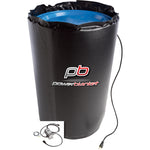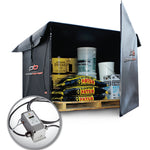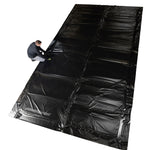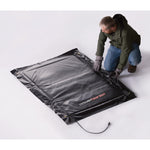You have no items in your shopping cart.
Can You Lay Brick in the Winter?
Article At-a-Glance
Can You Lay Brick in the Winter?
Yes, you can lay brick in the winter by ensuring the mortar and bricks are properly heated, using insulation blankets to maintain warmth, and following best practices to prevent freezing, even in temperatures as low as 20°F.
Key Takeaways
- Ensure Proper Temperature Control: Maintain mortar and brick temperatures above 40°F to prevent freezing; use heated curing blankets and tote heaters for effective warming.
- Site Preparation is Key: Clear snow and ice, thaw frozen ground, and grade the area to prevent water pooling, ensuring a solid foundation for bricklaying.
- Use Specialized Techniques: Mix mortar to the right consistency, work quickly, and apply light water sprays to prevent freezing in temperatures as low as 20°F.
- Protect Against the Elements: Utilize insulation blankets and waterproof tarps to shield curing mortar from cold and moisture, ensuring structural integrity.
- Adopt Best Practices: Follow guidelines for cold-weather masonry to avoid common issues like cracking due to water infiltration and freezing.
Yes, you can lay brick and spread mortar in the winter. Read on to learn how to speed up winter construction projects.

$1,915.99 USD
10’ x 10’ Multi-Duty Thawing & Concrete Curing Blanket (120V)
Speed up your construction project with our heated curing blankets - perfect for cold weather conditions.
How to Brick and Mortar in Winter Weather
Many construction businesses slow down during the winter months. Cold weather has a way of making it seem like nothing can be done, but proper site prep, weather protection, and essential curing tools can keep the work going.

How to Properly Prep the Site Before Beginning Work
With low outdoor temperatures speeding up the drying time of mortar, you’ll have to work quickly to ensure bricks are placed exactly where they need to be. Before laying, have all materials, tools, and equipment in place and ready to go. Once you've confirmed everything is in order, you can begin prepping the site for work.
First, you'll need to ensure the site is ready for bricklaying. This includes ensuring that the site is clean and free of debris. If needed, clear the area of snow and ice. If the ground is frozen, thaw it before starting work using heated curing blankets.
Next, grade the brick-laying area. The area should be graded so that it slopes away from the building or structure. This will help to prevent water from pooling around the bricks.
Following area grading, compact the soil to create a solid foundation for the bricks. Use a tamper or a plate compactor to compact the soil. This helps prevent bricks from being laid unevenly or sinking after the project is completed.
Finally, spread a layer of sand over the area to level the surface. Now, it’s time to mix the mortar.
Mixing Mortar and Laying Bricks in Cold Weather
When working in cold weather, it's important to take certain precautions to ensure that the mortar sets properly and that the bricks don't freeze. One key step is to ensure that the mortar is properly mixed - it should be thick enough to stick to the trowel but thin enough to pour easily. Be sure to work quickly when laying bricks in cold weather, as they can freeze quickly and become difficult to work with.
Some bricklaying contractors have found that heating bricks up a bit helps prevent the mortar from freezing as you lay down each brick. Bricks can be heated in a number of ways, the most effective being to use a hot box or tote heater to warm bricks in bulk instead of one at a time.

Tote heaters provide bulk warmth to materials before they need to be used in a construction project.
Another cold-weather masonry tip is to spray a light amount of water every 2-3 hours on spread mortar to help keep it from freezing. This will work in temperatures as low as 20°F, but any lower will cause the spray itself to freeze.
Protecting the Brickwork from the Elements
Winter mortaring is very similar to curing concrete in cold weather. Essentially, both need two things to protect them from low temperatures: heat and waterproofing.
Heat for protecting curing brickwork is often found in the form of insulation blankets. These blankets trap in warm air, allowing the mortar to continue to strengthen even when temperatures are below freezing.
Waterproof mats like tarps are useful for preventing curing mortar from getting wet. If the mortar gets wet while curing, the mortar can weaken and become more susceptible to cracking. This can worsen if penetrating water then freezes as it mixes with the mortar.
Waterproof tarps and insulation blankets are critical to allowing mortar to cure in cold weather. Heated curing blankets, like those manufactured by Powerblanket, can both provide evenly-spread heat and waterproofing.

FAQ: Common Problems That Can Occur During Winter Bricklaying
Below are several frequently asked questions about problems with cold weather masonry:
What happens if you lay bricks in the cold? Water infiltration and freezing are the most common issues of winter bricklaying. Cold bricks can become brittle, allowing water to seep in and expand when it freezes. This will cause both bricks and mortar to crack, compromising the strength of the masonry.
What temperature is too cold for mortar? Mortar will freeze if spread in too cold of temperatures. Starting at 40°F and going down to 20°F, mortar should be heated in some way to prevent it from drying too quickly. Below 20°F, mortar is ineffective.
Can you do masonry work in cold weather? Yes, but the colder it is, the harder it gets to cure mortar.
Can I lay bricks with frost? While you can lay bricks in mortar in cold weather, frozen mortar will not bond with bricks. Warm the area you plan on laying as you prep the site.













